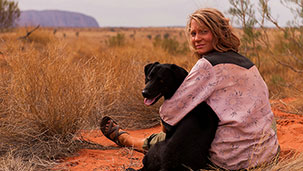When your human, Robyn Davidson, decided she was going to trek 1700 miles across the unforgiving Australian outback in 1975, there was never any question who would be by her side. In almost all of the National Geographic photos taken on her journey, there you are — usually at the edge of the frame, your black, four-legged silhouette the embodiment of canine loyalty. Though you have long since passed on, you were well represented in Tracks, the film of Davidson’s journey. In fact, it seems we learn the most about Davidson through her devotion to you.
The dog that plays you, Special Agent Gibbs, looks eerily like my dog, a black Lab/Doberman/Shepherd mutt. This would explain my almost irrational emotional attachment to your character. But regardless of the doppelgänger effect tugging at my heartstrings, your presence is essential to the narrative. Davidson did indeed set out to traverse some of the harshest environment on the planet without human accompaniment, but despite her best attempts at solitude, she certainly wasn’t alone.
There are some obvious parallels between Davidson in Tracks and that other recently celebrated “woman walks alone” biopic subject Cheryl Strayed in Wild. Both films are anchored by strong and understated performances; here, MiaWasikowska plays Davidson with unglamorous, wounded determination. Both women are in their early twenties, both lost their mothers, and both are fiercely independent (almost to the point of recklessness). One of the main differences between the women are Strayed’s lackadaisical approach to preparation versus Davidson’s two year build-up to her journey. Davidson spent this time living off the grid with you in an abandoned house while learning how to tame feral camels to carry her supplies for the trek. Strayed’s journey began in part because she had lost faith in herself. Davidson, it’s clear, has little faith in anyone but herself. And, of course, you.
Davidson wasn't a fan of being around people, which may partly explain why she reveled in leading her non-human family across the Outback. Her backstory is hinted at in conversation and in hazy, dream-like, flashbacks. Many of which only obliquely reference her mother’s suicide while focusing on Davidson’s attachment to the family Retriever named Goldie. We begin to see why she became so dependent on you. Like the best dogs, you possess many admirable traits; you’re smart, loyal, protective, emotionally intelligent and affectionate. Best of all, you want next to nothing in return.
Desperate for finances, Davidson begrudgingly approaches National Geographic for sponsorship on advice from an American photographer she meets. Much to her chagrin, this photographer, Rick Smolan will join her at various points to document her journey. Adam Driver portrays Smolan as an irritating yet loveable cross between Woody Allen, and Dennis Hopper’s manic photojournalist character from Apocalypse Now. His obvious affection for Davidson could only be described as puppyish, yet his gorgeous photos are credited as being the inspiration for the look of the film.
Cinematographer Mandy Walker deftly shows us that the Australian landscape is as visually stunning as it is brutal. Her approach is deliberate and hypnotic. With its rich orange sand and deep red rocks contrasted by an infinite azure sky, it’s no wonder Davidson didn’t want to share these views with anyone but you and her camels. When she needs accompaniment from an Aboriginal elder to traverse sacred grounds, she feels a great kinship with her escort, Mr. Eddy. For hundreds of miles the two conduct a true Aussie walkabout in silent reverence for their surroundings.
One of the best things about having a dog is never feeling alone. Davidson was fortunate to have you to tell all her secrets. But unfortunately for the audience, we aren’t privy to her motivations or desires, which makes her triumph less satisfying than it should be. But Tracks’ breathtaking locations and lush cinematography more than make up for its trudging pace and unfulfilling character development.
If you were anything like my dog, you didn’t care where you went, so long as you were outside. Dogs seem to understand that the journey is its own reward.
Who’s a good girl? You are.
Di







